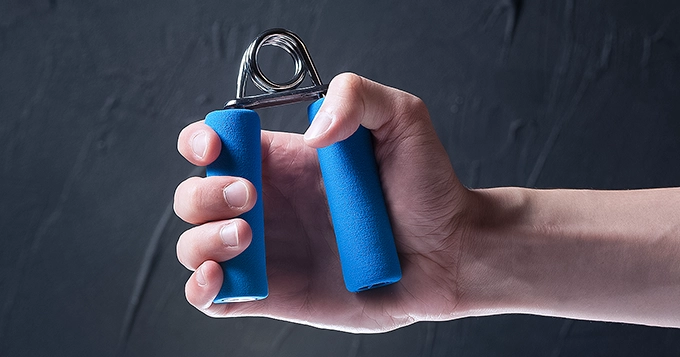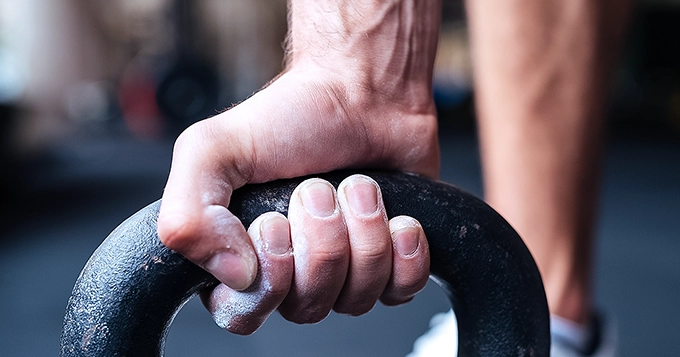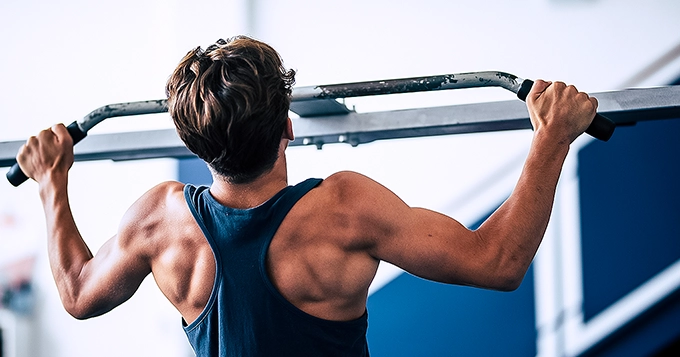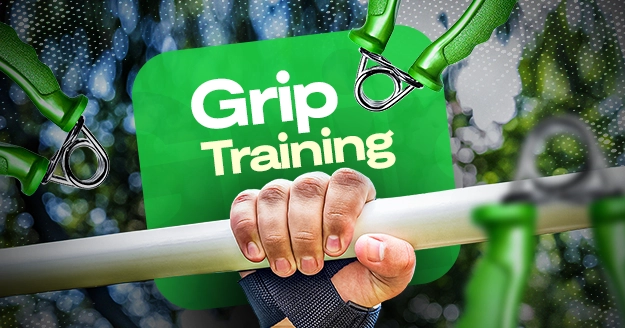Understanding Grip Strength
Grip strength is the force generated by the muscles in your hand, wrist, and forearm when you grasp an object. It includes several types:
- Crush Grip: This type of grip strength measures the force you can exert when crushing an object between your palms and fingers, such as when squeezing a bottle of ketchup or swinging a baseball bat.
- Pinch Grip: Pinch grip evaluates the strength of your pinch, which is the force you can apply when pressing an object between your fingertips and thumb. This is used in tasks like holding a pen or pencil.
- Support Grip: Support grip refers to the endurance of your grip, or how long you can maintain a hold on an object. This is crucial for activities like carrying groceries or performing pull-ups.
Importance of Grip Strength
Why is it important to do grip strength exercises? Let’s find out.
- Better Hand Health. Regular hand strengthener exercises can prevent or alleviate conditions like arthritis and carpal tunnel syndrome by keeping the muscles and joints healthy and flexible.
- Enhanced Grip Endurance. In activities requiring prolonged grip, such as rowing or cycling, improved hand strength helps maintain performance and reduce fatigue over time.
- Improved Athletic Performance. A strong grip is vital for athletes in sports like rock climbing, weightlifting, and martial arts. It allows for better control and power, directly enhancing performance.
- Improved Bone Density. Weight-bearing exercises, including those focused on grip strength, can help improve your bone density. This also reduces your risk of osteoporosis and fractures.
- Improved Cardiovascular Health. Some grip training exercises, like farmer’s walks, provide cardiovascular benefits by increasing heart rate and promoting overall cardiovascular health.
- Improved Confidence. Having a strong grip can boost your confidence in both sports and daily activities. Knowing you have the strength to handle various tasks enhances self-assurance.
- Improved Functional Strength. Everyday tasks such as opening jars, carrying groceries, or gripping tools become easier with enhanced hand strength. This functional strength improves your quality of life and independence.
- Improved Posture. Grip strength training often involves exercises that engage the shoulders and upper back, contributing to better posture and overall muscle balance.
- Reduced Risk of Injury. Strengthening your hands, wrists, and forearms helps stabilize joints and reduces your chances of strains and sprains. A strong grip can prevent injuries related to falls or sudden impacts.
What Exercises Improve Grip Strength
Here are some effective grip strength exercises to incorporate into your grip training routine:
- Tennis ball squeeze
Squeezing a tennis ball is an excellent way to engage your wrist and finger flexors, enhancing your crush grip. Alternatively, you can use a foam stress ball for this effective exercise.
Step 1: Hold the ball in one hand with your palm facing up Make sure your elbow is bent at a 90-degree angle.
Step 2: Use your four fingers to squeeze the ball as hard as you can, without using your thumb.
Step 3: Maintain the squeeze for 5 seconds, then release.
Step 4: Repeat the clench-and-release motion 10 times.
Step 5: Perform steps 1 through 4 with your other hand.
- Towel Wringing
This exercise targets your crush grip and strengthens the muscles essential for support grip. Begin with a small hand or face towel, gradually progressing to a larger towel as you build strength.
Step 1: Wet a towel and grasp each end, holding it horizontally in front of you.
Step 2: Twist the ends of the towel in opposite directions to squeeze out the water.
Step 3: Repeat.
- Reverse Wrist Curls
Reverse wrist curls effectively strengthen your forearm muscles, enhancing grip strength.
Step 1: Sit upright on a bench, holding a barbell with both hands facing down. Alternatively, you can use a dumbbell in each hand.
Step 2: Lean forward. Then, rest your forearms on your knees, keeping your wrists extended beyond your knees.
Step 3: Make sure you keep your forearms on your legs before lifting the weight by bending your wrists back.
Step 4: Slowly lower the weight, allowing your wrists to curl down.
Step 5: Repeat.
- Farmer’s Carry
The farmer’s carry, or farmer’s walk, is an excellent exercise for developing a strong support grip and targets several upper-body muscles, including the forearms, biceps, and triceps. Kettlebells or dumbbells can be used for this exercise.
Step 1: Hold a heavy dumbbell in each hand. Select the heaviest weights you can handle safely.
Step 2: Stand up straight, engaging your shoulders, back, and core.
Step 3: Walk the length of a room and back. If this feels too easy, you may need to use heavier weights.
- Plate pinch
As the name suggests, the plate pinch exercise is designed to strengthen the pinch grip muscles.
Step 1: Stand with the side of a weight plate resting against your calf.
Step 2: Squat down and grab the plate, pinching it with your thumb on one side and your four fingers on the other.
Step 3: Stand back up and hold the plate for around 10 to 15 seconds.
Step 4: Squat down to rest, then repeat several times on each side.
To increase the intensity, you can use a heavier plate or walk while pinching the plate.
- Dead Hang
This exercise targets the forearm, hand, and wrist flexors to enhance your support grip.
Step 1: Raise your arms to grip the bar with your hands slightly wider than shoulder-width apart and your hands facing away from your body.
Step 2: Hang with your arms fully extended and your core engaged for as long as you can manage.
Step 3: Repeat.
- Pull-Ups
Pull-ups are excellent for strengthening your support and crush grip, as well as the muscles in your arms, shoulders, chest, and back. This exercise can be challenging to master, so it’s helpful to start with dead hangs and gradually increase your repetitions.
Step 1: Stand under a pull-up bar with your back straight. Raise your arms to grab the bar with your hands slightly wider than shoulder-width apart.
Step 2: Lift your body by bending your elbows until your chin is above the bar. Hold briefly, ensuring minimal body swing.
Step 3: Lowering: Slowly lower yourself back to the starting position.
Step 4: Repeat.
Begin with a few repetitions and progressively increase the number as your strength improves.
- Wrist Flexor Stretch
The wrist flexor stretch is beneficial for improving flexibility and reducing tension in your wrist and forearm muscles.
Step 1: Stand or sit with your arm extended in front of you, palm facing up.
Step 2: Use your other hand to gently pull your fingers towards your body until you feel that stretch in your wrist and forearm. Keep your elbow straight.
Step 3: Hold the stretch for 15-30 seconds, making sure not to overextend.
Step 4: Release the stretch and repeat on your other hand.
You can also use a grip strengthener to improve your grip strength.
How to Use Grip Strengthener
Step 1: Standard Grip Exercise
- Position one handle of the hand grip against your palm.
- Hold the other handle.
- Squeeze the handles together as hard as you can.
- Hold the closed position.
- Slowly release your grip.
- Begin with two sets of 10 squeezes for each hand. Gradually increase to four sets over several weeks as your strength improves.
Step 2: Reverse Grip Exercise
- Hold the hand grip between your palm and fingers, as close to the fingertips as possible.
- Close the grip using both hands.
- Remove your “helper” hand.
- Release the grip as slowly as possible.
- Start with two sets of five reverse squeezes for each hand. Increase to four sets as your strength improves.
Step 3: Finger Curl Exercise
- Place the hand grip against your palm.
- Position the tips of your fingers on the springs or “buttons.”
- Close the springs by curling your fingers toward your palm.
- Slowly release your grip.
To add difficulty, curl in one finger at a time. Start with one set of 10 finger curls for each hand, gradually increasing to three or four sets as you progress.








